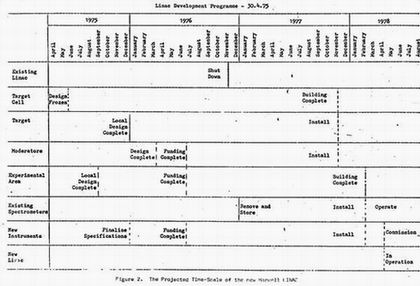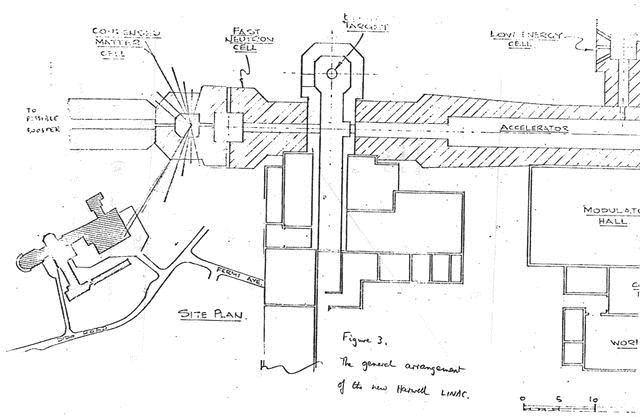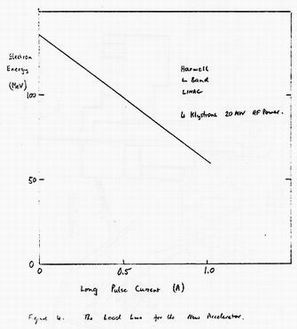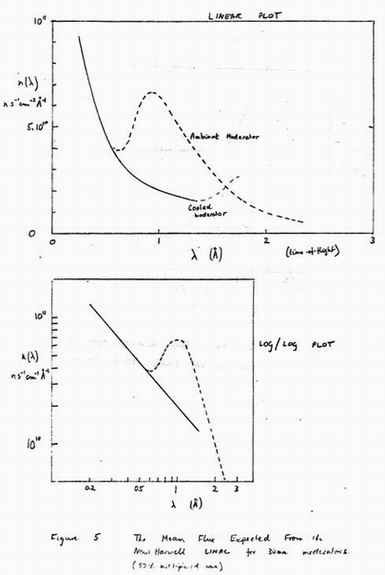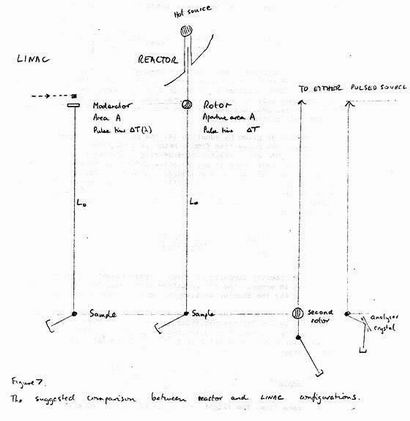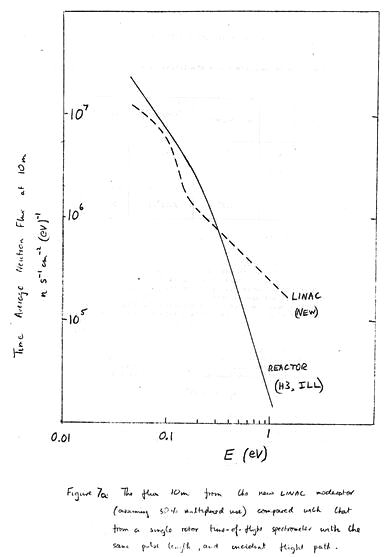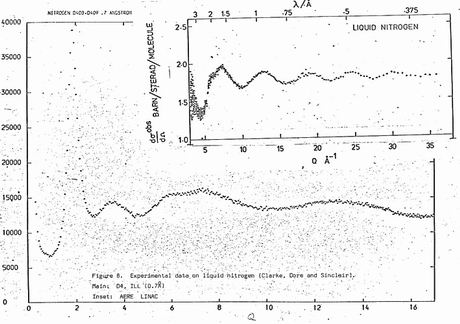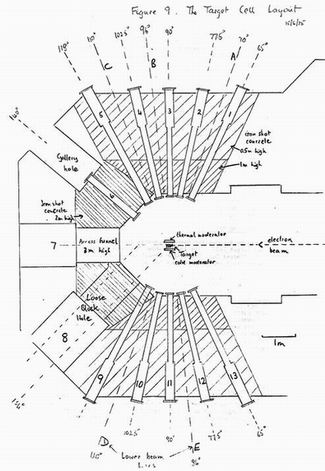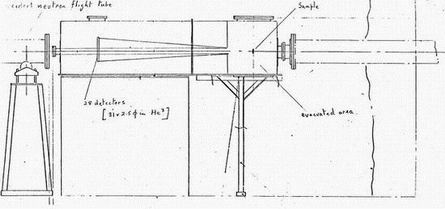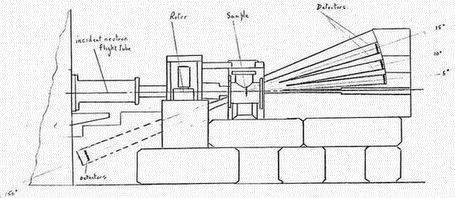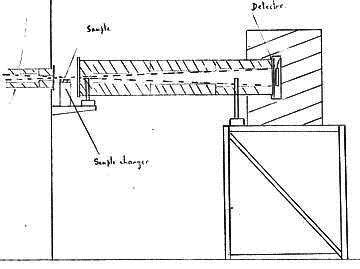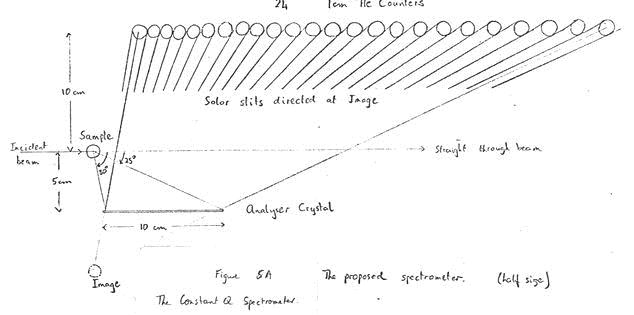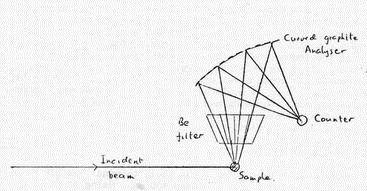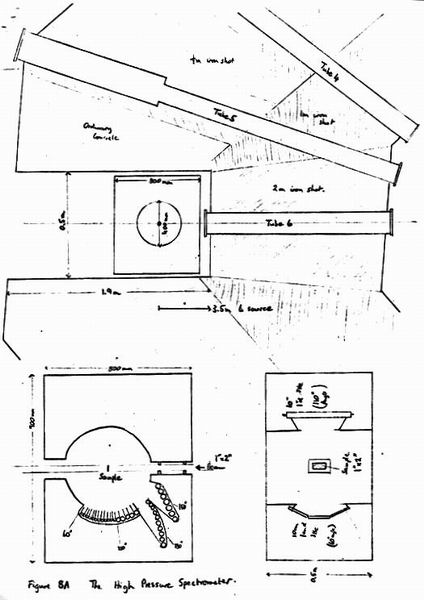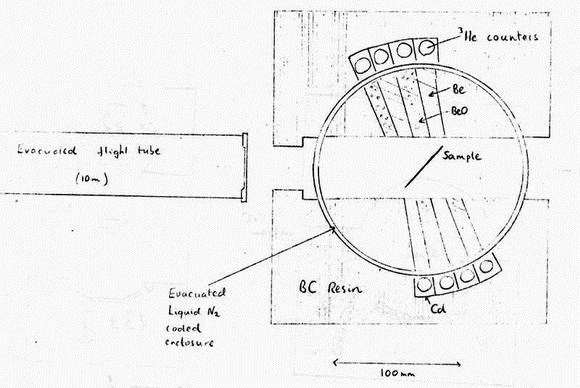Introduction 1. The advantages of using a pulsed electron LINAC as a thermal neutron source for diffraction experiments were realised during the fifties (Egelstaff, 1953). Compared with a reactor neutron beam pulsed by a convetnntional rotor system, they give a relatively high epithermal neutron flux, relatively short pulse times, allowing short flight paths, and relatively larged pulsed beam areas. The intrinsic neutron background should be less because the g and fast neutron contributions come as a "flash" essentially when the LINAC fires and scarcely exist between pulses when the slow neutron signal is being counted.
2. The present Harwell LINAC was installed in 1959 largely for nuclear Physics purposes, but since 1967 there have been a number of condensed matter experiments. Initially the programme was one of exploiting the techniques possible using the LINAC, including neutron moderation (Day and Sinclair, 1969 and Sinclair 1968) and spectrum calibration (Day, Johnson and Sinclair, 1969). Later work in the nature of demonstration experiments was performed on single crystal Mn5Ge3 (Day and Sinclair. 1970) and on inelastic molecular spectroscopy (Day and Sinclair, 1971). In 1971 the work aquiared new impetus with ths commissioning of the Total Scattering Spectrometer (TSS). This spectrometer rapidly acquired an appreciable joint SRC/Harwell programme in the field of structure factor measurements from liquids and amorphous solids at high scattering vectors Q. The programme was reviewed by an NBRC Working party chaired by Dr Clark in 1973 (NBR p. 201). This group recommended further imporovements in the counter assembly and in data handling which have now been implemented. The present programme has been recently reviewed (Sinclair et al, 1974). Experiments have been performed on the gases nitrogen and oxygen (Page and Powles 1975), the liquids nitrogen and oxygen (Clarke et al, 1975), heavy water, phosphorus, bromine (Clarke et al, 1975). gallium and carbon disulphide molten polymer polytetrafluoroethylene, the amorphous materials silica and germania (Wright and Sinclair, 1975) as well as several powder spectra. The nitrogen work is gratifying in giving possibly the first published example of a problem where measurements to comparable accuracy and resolution have not been possible on any reactor including the Grenoble reactor with its hot source.
3. There has also been successful experimental programmes on other electron LINACS of comparable power. These include the Rensselaer Polytechnic institute, USA, LINAC where several inelastic experiments have oeen performed (e.g. Kironac et al, 19670;Pan and Webb, 1985), the Tohoku LINAC in Japan where there exists a complex of 8 beam holes covering both elastic and inelastic spectrometers (Euratom 1973), and a smaller inelastic programme at Toronto, Canada (Egelstaff et al, 1975).
4. We must also review the status of other projects for the production of pulsed neutrons other than by the electron LINACS (see Hobbis 1974). Other processes which might be used are fission, proton spallation and fusion. All these methods have the intrinsic advantage that they produce less target heat to be dissipated per neutron produced. The heat produced from electrons, fission, protons and fusion are respectively 2000. 100, 40 and 17 MeV per neutron produced The fission process may be exploited either in a pulsed reactor or a sub-critical neutron booster. The pulsed reactor IBR 30 at Dubna, Russia, has operated for some years (Alberquerque, 1969) and has a peak thermal flux of 1014ns-1cm-2. However its long pulse time of 90 mseconds has meant the use of very long flight paths with consequently reduced count rates, not to mention instrumental costs. The project IBR 2 should give an impressive x100 performance with 1016ns-1cm-2 peak thermal fluxes.
These long pulse-times are avoided by the sub-critical boosters as existing for a nuclear physics programme on the LINAC at Harwell (Poole and Wiblin, 1958). Used on the new Harwell LINAC a booster giving a multiplication factor of order 50 can be constructed without damaging pulse lengthening or background from delayed neutrons between pulses. Such a project is being discussed at Oak Ridge as part of the ORELA electron LINAC. Larger multiplications are possible using mechanically modulated boosters as in the "Super-booster" project (Poole, 1967) but at much greater cost and complexity.
Proton spallation sources give short intense neutron pulses with less
problems in heat dissipation. The ZING project proposed by Argonne National
Laboratory in 1972 (Carpenter and Marmer 1972) would have provided
1015ns-1cm-2
peak fluxes. This proposal has now been superseded by a more ambitious project,
IPNS, which will use the new proton synchrotron to give peak neutron fluxes of
1016ns-1cm-2
(Carpenter and Price, 1975). Already, prototype ZING-P
experiments have been carried out at Argonne with peak fluxes of around
1013ns-1cm-2.
Elastic experiments on several powder and amorphous samples
(Beyerlein et al, 1974, Beyerlein et al, 1975), and inelastic measurements on
molecular vibrations in hydrogenous compounds (Mildner, Private Communications)
have been completed with results showing great promise for the larger machines.
Laser fusion sources are necessarily pulsed and have the desirable
characteristic of relatively long periods between pulses. Their progress
must be awaited eagerly in any consideration of an ultimate pulsed source.
The New Harwell LINAC Project
5. The project for a new LINAC at Harwell obtained its impetus from the
Nuclear Physics Division. They wished to replace the existing one with one
representative of the best technology of proven reliability that was
available "off the shelf". The machines considered were L-band (1300 MHz)
LINACS built by Radiation Dynamics of Swindon, which are available in
modular form in up to four modules. The machine originally considered was
a 2 module machine capable of delivering an electron power of order 40 KW
to a target. Assuming a 50% multiplexed use for condensed matter use this
would have given a mean flux gain of around 5 over the present LINAC,
6. The proposal was considered in detail by the LINAC working party chaired
by Dr. Hobbis (NBR/LRG/75, P.7). This considered the experimental
programme possible with LINACS, the likely portfolio of spectrometers which
could be justified, and attempted the complex task of making fair comparisons
between LINAC and reactor performance. It appeared that in the field of
epithermal energy neutrons (0.2 - 1 eV) where the fast pulse times from the
LINAC could he exploited, even the present LINAC was competitive with
reactors (LIWP/P.8). In the case of liquid studies where back scattering
can be exploited, the existing LINAC actually out-performed the hot-source
at Grenoble at short wavelengths <0.5AMS, (LIWP/P.9). Studies for a high
relolution (Dd/d = 0.03) Back Scattering Powder Spectrometer (LIWP/P.4) and
an inelastic rotor spectrometer (LIWP/P.3) appeared feasible using the
present LINAC and programmes to implement these spectrometers have now gone
forward (NBR/LRG/75/P.4, HNBFC/73/P.2). It was felt that in some respects
the Harwell proposal was over-modest and that appreciable SRC investment
should centre around a more powerful LINAC.
7. The proposal finally approved by the treasury in December 1974 was
for a four module LINAC giving 90 KW beam power which in 50% multiplexed
use would give order of magnitude gains in the condensed matter counting
rates. The time-scale for the project is outlined in figure 2. The new
LINAC is expected to be operational in the Spring of 1976. By phasing the
building construction it was possible for the present LINAC, including
condensed matter work on cell II, to be continued until the end of 1976.
Of the major components noted, the condensed matter target cell is the most
critical and has to be defined by the end of May 1975. This is being done
through a discussion group of present users held at Harwell. The LINAC, the
target cells and targets are being funded solely by Harwell. This part of
the work is under the control of the Project Officer, Dr. Eric Lynn of
Nuclear Physics Divison, with the help of a Project Management Committee
(LAPMC) and a Technical Advisory Committee (LATAC). The target hall of
the condensed matter facility, the instrument protfolio and their associated
support facilities have not yet been defined or funded.
The Specification of the New LINAC
8. The general arrangement of the new LINAC is shown in figure 3. It
fires from the north side at right angles to the existing LINAC so that the
existing Nuclear Physics booster and its associated flight tubes might
remain unchanged by bending the electron beam by 900 and slightly downwards
to join the beam line of the existing LINAC. Down the new LINAC beam line
in the position formerly occupied by cell III would be a Fast Neutron Target
for nuclear physics use and the Condensed Matter Cell. A Low Energy Cell
would be placed after 2 LINAC sections for 7-30 MeV electron irradiation
work.
9. The detailed specification of the new LINAC has been given in LATAC/75/
P.2. Its minimum performance as given by the acceptance tests is only
slightly inferior. Run in an "open circuit" condition with negligible beam
power, the accelerator gives its full electron voltage of 136 MeV. At the
higher beam powers needed for condensed matter research the output voltage
drops following the "load line" given in figure 4. The acceptance test
confirming this important curve is that for 0.75A pulse current the voltage
should be at least 72 MeV. within the constraint of the load line there is
considerable flexibility in choice of pulse repetition frequencies and
pulse times. Standard pulse repetition frequencies are 150, 300, 600 and
1200 p.p.s. and standard pulse lengths for condensed matter use of 0.4, 1, 2
and 5 mseconds.
10. Linac pulses can be switched or muliplexed between the booster, the
low energy cell and either the fast neutron cell or the condensed matter
cell. (Provision for multiplexing between these two cells can be made at
a later date). Pulse length modulation is possible so that short pulses to
the booster and long pulses to the condensed matter cell are feasible. At
present pulse current modulation is not possible so that the low pulse
currents appropriate to the long pulse condensed matter experiments will
embarrass multiplexing with the very short pulses required by the low energy
cell and fast neutron cell who could use much higher currents of order 6A.
Because of these points non-multiplexed sole usage is expected during the
fast neutron cell operation.
11. Some of the multiplexed modes of operation which are envisaged for
routine use have been given by Lynn in LATAC/75/P.4. The most important
for condensed matter usage are as follows.
